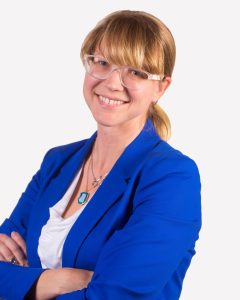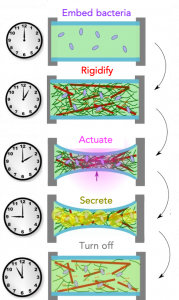Jennifer Ross, professor and department chair of physics in the College of Arts and Sciences (A&S), is among a team of researchers who was recently awarded a $1.8 million grant from the National Science Foundation (NSF) to design and create next-generation materials inspired and empowered by biological cells.

The project, led by Rae Robertson-Anderson, chair and professor of physics and biophysics at the University of San Diego, also includes physicists, biologists and engineers from the University of California Santa Barbara, the University of Chicago and Rochester Institute of Technology. Its goal is to create self-directed, programmable, and reconfigurable materials – using biological building blocks including proteins and cells – that are capable of producing force and motion. This research could pave the way for future materials applications ranging from self-healing bridges and self-propulsive materials to programmable micro-robotics, wound healing and dynamic prosthetics.
According to Ross, the team’s work is inspired by biological materials that have the ability to heal, form and reform, and respond to their environment. But where inherently soft biological materials degrade easily, the group’s proposed hybrid composite material – a mix of synthetic and biological parts – would produce a durable system that can autonomously cycle. An example could be a road made of a material that could release molecules and self-repair each night.

But how do you get a synthetic material to mimic biological activities like healing? The short answer is bacteria. Ross explains that these materials will be actuated by microorganisms, like bacteria, that go through Circadian cycles that should allow the material to change over time. Similar to the cycle of the sun rising and setting each day, bacteria will work on a programmable schedule without human intervention and activate materials to stiffen, compress, soften and re-expand.
Ross’s contribution involves an essential mechanical part of the material they are engineering called the cytoskeleton. The cytoskeleton is the protein-based skeleton of the cell that helps it maintain shape and provides mechanical support, enabling it to carry out functions like division and movement.
Ross explains that the cytoskeleton, which is made of a network of protein filaments, is an ideal system for these materials because they are rigid and flexible, providing mechanical stiffness. She will work with another team member to embed bacteria into the cytoskeleton that can excrete molecules that degrade or build back the filaments on a schedule.
Ross says the team is hopeful that this novel research will ultimately lead to the creation of fully synthetic materials that can mimic biological activities.
“I am always in the pursuit of better materials to help make our world more sustainable,” says Ross. “This research is very cutting-edge because there are currently no composite biological and synthetic materials of this type that are robust and responsive. This is a great complement to what other A&S faculty are doing in the sustainability space and I’m proud to be part of it.”
The four-year grant will also allow for undergraduates at each university to gain hands-on research experiences, mentoring, and professional development opportunities. At the end of the project, the team will have built the framework for their materials design concept, including a small prototype, that can help others to advance futuristic materials to accomplish the many processes that living systems already perform seamlessly, such as healing and regulating themselves.
Funding for the project begins on October 1. Read more about Ross’s NSF award.
By Dan Bernardi
Portions of this article have been adapted from a press release distributed by the University of San Diego.
